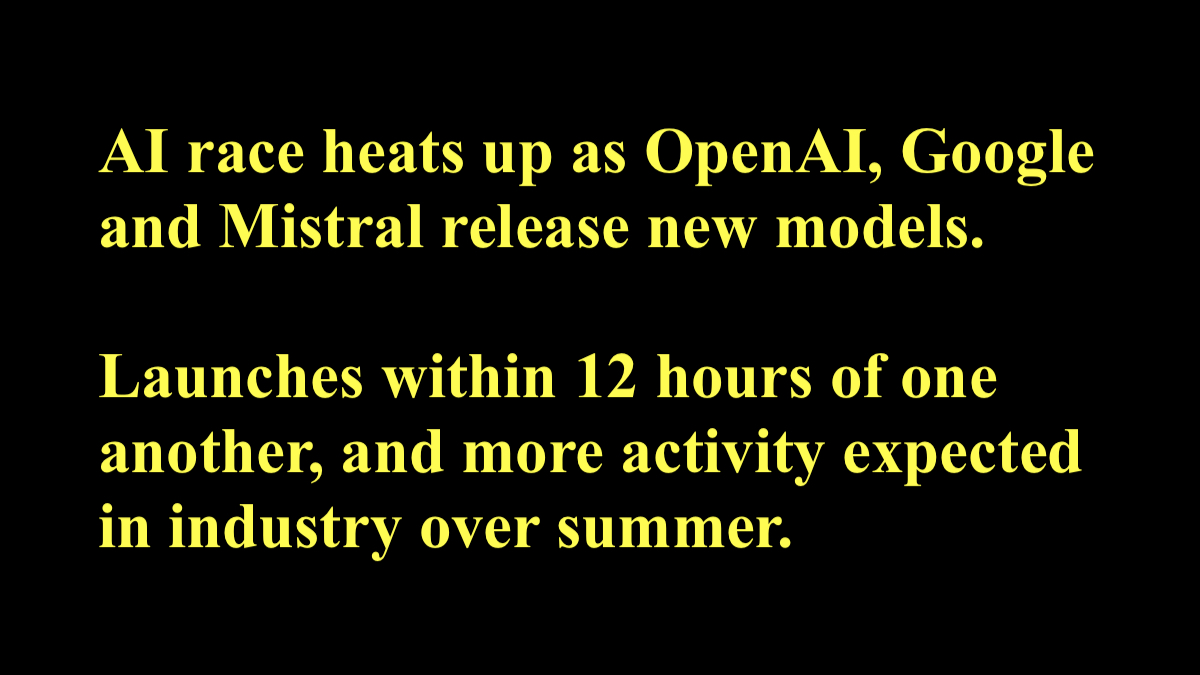A very good read from a respected source!
Summary of “AI Race and Model Releases” from a Scientific and Engineering Perspective:
The provided article highlights the rapid advancements and intense competition within the AI field, specifically focusing on large language models (LLMs). Here‘s a breakdown from a scientific and engineering perspective:
Key Players and Models:
OpenAI: Released GPT–4 Turbo, a multimodal LLM capable of processing text and images. Expected to release GPT–5 soon.
Google: Released Gemini Pro 1.5, a multimodal LLM handling text, images, audio, and video. Offers a free tier with limited usage.
Mistral: A French startup released Mistral 8x22B, an open–source LLM accessible for download and further development.
Meta: Planning to release Llama 3, with initial smaller versions leading up to a more advanced model later this summer.
Technical Advancements:
Multimodality: LLMs are evolving beyond text–only processing to handle various data types like images, audio, and video. This opens doors for richer applications and a deeper understanding of the world.
Open–Source vs. Closed Models: The debate continues regarding the benefits and risks of open–sourcing LLMs. While it fosters collaboration and accessibility, concerns remain about potential misuse and the inability to control harmful applications.
Challenges and Future Directions:
Limits of LLMs: Experts like Yann LeCun question whether current LLM approaches are sufficient for achieving artificial general intelligence (AGI). While impressive in language tasks, they lack the ability to understand and interact with the physical worldeffectively.
Ethical Considerations: As models become more powerful, ethical concerns around bias, misuse, and societal impact requirecareful consideration and mitigation strategies.
Overall, the AI field is experiencing rapid progress, with companies competing to develop increasinglysophisticated LLMs. The focus is shifting towards multimodal capabilities and exploring the limitations ofcurrent approaches. Ethical considerations and responsible development remain crucial aspects of this evolving landscape.
THE GUARDIAN. AI race heats up as OpenAI, Google and Mistral release new models.
Launches within 12 hours of one another, and more activity expected in industry over summer
OpenAI, Google, and the French artificial intelligence startup Mistral have all released new versions of their frontier AI models within 12 hours of one another, as the industry prepares for a burst of activity over the summer.
The unprecedented flurry of releases come as the sector readies for the expected launch of the next major version of GPT, the system that underpins OpenAI’s hit chatbot Chat-GPT.
The first came only hours after Nick Clegg appeared on stage at an event in London, where he confirmed reports that the third version of Meta’s own AI model, Llama, would be published in a matter of weeks.
Seven hours after Clegg left the stage, Google’s Gemini Pro 1.5, his competitor’s most advanced large language model, was released to the general public, with a free tier limited to 50 requests a day.
An hour later, OpenAI released its own frontier model, the final version of GPT-4 Turbo. GPT-4 Turbo and Gemini Pro 1.5 are “multimodal” systems, able to accept more than just text. Each can take image input, while Gemini can also accept audio and video.
In the early hours of the morning in France, Mistral, an AI startup founded by a number of Clegg’s former colleagues in Meta’s AI team, released its frontier model, Mixtral 8x22B. Unlike its two American competitors, Mixtral was released through a simple download link to a 281GB file: the company, like Meta, takes an “open source” approach, and publishes its AI systems free for anyone to download and build upon.
That approach has been criticised as potentially dangerous, since it leaves the developer unable to intervene and stop its systems being used for harmful ends, nor to pull models offline if vulnerabilities or biases are discovered and need to be fixed. Others, including Meta, defend it as ultimately leading to better outcomes than systems “kept in the clammy hands of a small number of very, very large, well-heeled companies in California”.
Meta’s Llama 3 is expected to be released initially in its smaller, less powerful versions, according to a report from The Information, building up to a release of the company’s most advanced frontier model this summer. However, it may face stiff competition: OpenAI is believed to be planning a similar timeframe for its next GPT model, GPT-5, with the company’s chief operating officer, Brad Lightcap, telling the Financial Times it would be coming “soon”.
However, experts have queried whether the “large language model” approach shared by all frontier AI systems might be hitting its limits. “We hear a lot of people saying: ‘Oh my God, we’re going to get [artificial general intelligence] within the next year,” said Meta’s chief AI scientist, Yann LeCun, responding to a claim from the xAI founder, Elon Musk. “It’s just not happening. We have AI systems that can pass the bar exam, but they can’t clear up your dinner table and fill up the dishwasher. We have systems that manipulate language, and fool us into thinking that they are smart, but cannot understand the world.”
Instead, LeCun suggested, researchers needed to work on what he called “objective-driven” AI with the ability to reason and plan about the world, rather than just work on words alone.
That approach might generate AI systems with truly superhuman abilities, LeCun said. That “is more of a vision than anything else”, he added, “but it’s making exponential progress, so I’m pretty confident that we’ll get there”.


